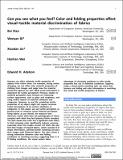| dc.contributor.author | Xiao, Bei | |
| dc.contributor.author | Bi, Wenyan | |
| dc.contributor.author | Jia, Xiaodan | |
| dc.contributor.author | Wei, Hanhan | |
| dc.contributor.author | Adelson, Edward H | |
| dc.date.accessioned | 2017-07-11T14:48:18Z | |
| dc.date.available | 2017-07-11T14:48:18Z | |
| dc.date.issued | 2016-02 | |
| dc.date.submitted | 2015-06 | |
| dc.identifier.issn | 1534-7362 | |
| dc.identifier.uri | http://hdl.handle.net/1721.1/110625 | |
| dc.description.abstract | Humans can often estimate tactile properties of objects from vision alone. For example, during online shopping, we can often infer material properties of clothing from images and judge how the material would feel against our skin. What visual information is important for tactile perception? Previous studies in material perception have focused on measuring surface appearance, such as gloss and roughness, and using verbal reports of material attributes and categories. However, in real life, predicting tactile properties of an object might not require accurate verbal descriptions of its surface attributes or categories. In this paper, we use tactile perception as ground truth to measure visual material perception. Using fabrics as our stimuli, we measure how observers match what they see (photographs of fabric samples) with what they feel (physical fabric samples). The data shows that color has a significant main effect in that removing color significantly reduces accuracy, especially when the images contain 3-D folds. We also find that images of draped fabrics, which revealed 3-D shape information, achieved better matching accuracy than images with flattened fabrics. The data shows a strong interaction between color and folding conditions on matching accuracy, suggesting that, in 3-D folding conditions, the visual system takes advantage of chromatic gradients to infer tactile properties but not in flattened conditions. Together, using a visual–tactile matching task, we show that humans use folding and color information in matching the visual and tactile properties of fabrics. | en_US |
| dc.description.sponsorship | Google (Firm) (Faculty Grant) | en_US |
| dc.language.iso | en_US | |
| dc.publisher | Association for Research in Vision and Opthalmology | en_US |
| dc.relation.isversionof | http://dx.doi.org/10.1167/16.3.34 | en_US |
| dc.rights | Creative Commons Attribution-NonCommercial-NoDerivs License | en_US |
| dc.rights.uri | http://creativecommons.org/licenses/by-nc-nd/4.0/ | en_US |
| dc.source | Journal of Vision | en_US |
| dc.title | Can you see what you feel? Color and folding properties affect visual–tactile material discrimination of fabrics | en_US |
| dc.type | Article | en_US |
| dc.identifier.citation | Xiao, Bei et al. “Can You See What You Feel? Color and Folding Properties Affect Visual–tactile Material Discrimination of Fabrics.” Journal of Vision 16.3 (2016): 34. © 2015 Association for Research in Vision and Ophthalmology | en_US |
| dc.contributor.department | Massachusetts Institute of Technology. Computer Science and Artificial Intelligence Laboratory | en_US |
| dc.contributor.department | Massachusetts Institute of Technology. Department of Brain and Cognitive Sciences | en_US |
| dc.contributor.mitauthor | Jia, Xiaodan | |
| dc.contributor.mitauthor | Wei, Hanhan | |
| dc.contributor.mitauthor | Adelson, Edward H | |
| dc.relation.journal | Journal of Vision | en_US |
| dc.eprint.version | Final published version | en_US |
| dc.type.uri | http://purl.org/eprint/type/JournalArticle | en_US |
| eprint.status | http://purl.org/eprint/status/PeerReviewed | en_US |
| dspace.orderedauthors | Xiao, Bei; Bi, Wenyan; Jia, Xiaodan; Wei, Hanhan; Adelson, Edward H. | en_US |
| dspace.embargo.terms | N | en_US |
| dc.identifier.orcid | https://orcid.org/0000-0003-2222-6775 | |
| mit.license | PUBLISHER_CC | en_US |
| mit.metadata.status | Complete | |

